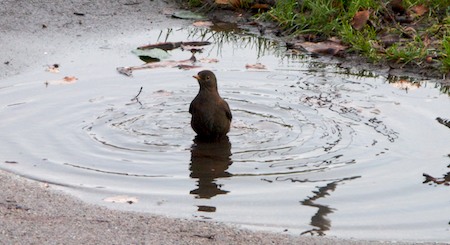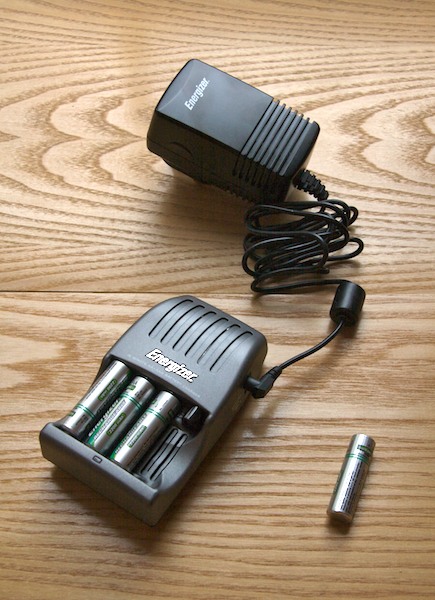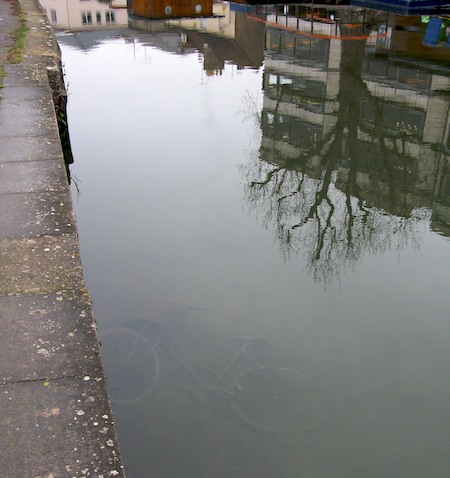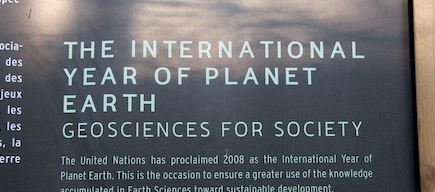
A puddle paddle.

A puddle paddle.
 Six months ago, I bought a new Energizer battery charger because I needed one which would handle AAA batteries as well as AAs. I commented at the time on my surprise at its incorporation of a big fan and a whopping great power supply – needed because it can recharge batteries in 15-20 mins.
Six months ago, I bought a new Energizer battery charger because I needed one which would handle AAA batteries as well as AAs. I commented at the time on my surprise at its incorporation of a big fan and a whopping great power supply – needed because it can recharge batteries in 15-20 mins.
Well, six months on, I’m… well… a big fan. I get through a lot of batteries, and the fact that this can turn empty ones into full ones in the time I need to turn a full cup of coffee into an empty one is a wonderful asset – I now have a constant supply of power.
It is a little sniffy about which batteries it will take, though, and turns up its nose at my attempts to use some of my more elderly rechargables. This is probably sensible, since it’s about to pump considerable amounts of current into them. All the Energizer cells I’ve procured to use with it, though, have been just fine.
And then I wondered if this was deliberate. You see, there’s a big business opportunity here. Batteries are a necessity now, and if you can come up with ones that have some cool features — extra-long-life, built in LCD meters, perhaps, or the ability to change colour based on current consumption or charge level — then you could do quite well. (USBCELL is a nice example.) I like the idea of batteries which learn their typical use patterns and can communicate with others in the same device, so they can tell you that you’ll only get about two hours’ use, and it’s mostly the fault of the one on the left there.
But suppose you also come up with a cool charger, perhaps which incorporates a travel adaptor, the ability to charge from USB, to recharge your phone, a built-in solar trickle-charger… hey, it could include an MP3 player. Everything else does. You sell it really cheap. Everyone wants one. But you make it so that it only effectively recharges your batteries, and your batteries need to be charged by it. Perhaps the batteries have unique IDs and the charger can log information about them and display it. Maybe it could even order new ones for you when it thinks you need them.
Anyway, people might then invest a reasonable amount in your particular brand, and you then have an ongoing revenue model which I’m sure could make for a good MBA project, at least!
Time for some market research. What killer features would you like in your batteries?
This time, the River Cam, on a day when the water was unusually clear.

If you’re a spider, and you rely on catching your prey by surprise, then a frost like yesterday’s must be rather inconvenient.

“Wealth”, said H.L.Mencken a long time ago, “is any income which is at least $100 more a year than the income of one’s wife’s sister’s husband.”
We spend the first bit of our lives wishing we were older, and the remainder wishing we were younger.
For men, the changeover probably happens around the mid-thirties. For women, in the mid-twenties.
There’s probably an excellent evolutionary explanation based around attractiveness to the opposite sex and peak reproductive performance…
The BBC’s iPlayer is a truly wonderful thing, as I have mentioned before.
In general, the content is only available in the UK, in the same way that Hulu is only in the US, but it gives those of us who pay a BBC licence fee access to everything on the Beeb’s now numerous channels from the last week. And with the iPlayer Download options, you can download it to your machine and watch it for up to 30 days. This used to involve a Windows-only binary, but now you can click a link to be an iPlayer Labs tester and iPlayer items will automatically gain a ‘download’ option, which makes use of an Adobe Air-based application, meaning that it works on Macs and Linux too.
I’ve only just discovered this download facility, though. Before that, on our recent trip to Paris, I was surprised to discover that the free wifi in our little hotel was attached to rather a good internet connection. I logged into my home Linux machine and did a little magic which allowed me to persuade iPlayer that I was still in the UK, and we had some happy evenings watching very high quality content, including episodes we might otherwise have missed of the rather fun ghost story Crooked House.
Catch, or download, the omnibus edition while it’s still there…
As an aside, I’m interested to note that the vast majority of people visiting Status-Q are Mac users – over 80% – which is probably because I post quite a bit about Mac software, and partly, no doubt, because of the intelligence of the readership with which I am blessed 🙂 Of the Windows users, though, three-quarters are using Chrome, a few using Opera, a very few on Firefox, and Internet Explorer users are too few for any statistics to be significant. Interesting. It may indicate that more of you are reading at home than at work, perhaps…
I’ve spent today converting the old Ndiyo site, which used Plone as the CMS, into Drupal.
Plone was very cool when we set the site up many years ago, but it’s quite quirky, and very heavy on memory usage. On a dedicated machine this is not a problem, but when I’ve been setting up sites on a shared server, I can run rather a large number of Drupal sites in the RAM required for one Plone installation. With hosting services like the excellent Webfaction, there’s a pretty direct motivation to switch. One Plone site needs more than the base-level service and so will cost you more per month than several Drupal sites.
Besides, Drupal is wonderful. I’ve investigated many CMSes over the years and I’ve fallen in love with Drupal. It’s beautifully designed, despite the fact that it’s written in PHP, which for me is a bit like admitting that I like The Matrix even though it stars Keanu Reeves.
Drupal’s power is not immediately apparent, but if you’re willing to put some time into it, listen to the podcasts, Google for the screencasts, explore the contributed modules (of which there are now thousands), your effort will be repaid. I was very pleased with how quickly I got Rose’s new site up and running, for example.
Anyway, all of that is a long introduction to the fact that I wrote a Python script which helped me convert Plone content into Drupal content and I’ve posted it on qandr.org in case it’s useful to anyone.
Don’t you just love the way people like to declare that this is the ‘International Year of X’, where X might be almost anything? Walking in the Jardin des Plantes yesterday I came across this:

2008 is the International Year of Planet Earth, apparently. That’s no doubt been a constant reminder for those of you who have been tempted to spend too much of the last 12 months thinking about Jupiter. And it should have made anybody on Jupiter sit up and take notice, too. Though, of course, they would have different years… Anyway, I’m glad I heard about it on Dec 29th or I could have missed out altogether! This concern led me to do some research, and discover that 2008 is also The International Year Of
And that’s just from the UN. I kid you not. Other organisations have declared 2008 to be The International Year Of
…to name a few. And those are just the international ones. I’m looking for an imaginative way to combine all of these in the next two days. There must be something fun you can do by combining Frogs, Potatoes and Organ pipes…
Cynique? Moi? Not at all! And to prove it, I am hearby making an important announcement, which Status-Q readers are privileged to know before anybody else…
Yes, this coming year is the time when we can celebrate all of those other International Years, and, finally, give due recognition to those that nobody else noticed at the time.
I think this could be big…
A nice feature of Google maps:
You’ll get a nice map of your track. And you’ll even get information about how to link to it and how to embed it in your site. Here’s a section of the route I walked today, for example:
© Copyright Quentin Stafford-Fraser
Recent Comments